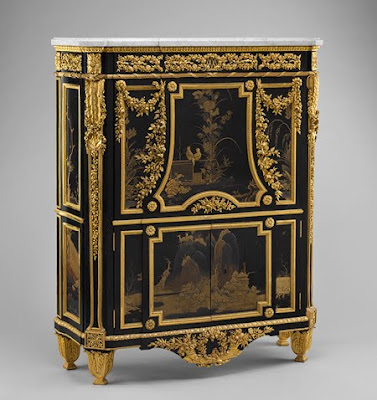 Prior to the 1800's, the traditional means of finishing furniture to a high gloss was accomplished by applying beeswax in thin layers with a cloth and then polishing it up to the desired gloss. These wax finishes did not always wear well over time and were easily damaged.
Prior to the 1800's, the traditional means of finishing furniture to a high gloss was accomplished by applying beeswax in thin layers with a cloth and then polishing it up to the desired gloss. These wax finishes did not always wear well over time and were easily damaged.The introduction of shellac as a furniture finish started gaining popularity in France around 1810-1820, particularly via a technique called “French Polish”, a technique of applying shellac in layers by rubbing it laboriously on the furniture with a cloth pad. It was the favored finish for most exotic woods, fine furniture, antiques and musical instuments, spreading quickly to Britain and the rest of Europe, and finally to America. To this day some of the finest museum pieces still have their original shellac finish.
What Is Shellac?
Shellac, as the word is commonly used, refers to all forms of purified lac - a natural resin secreted by a tiny insect called Laccifera Lacca. This insect, native to certain forests in India and Thailand, feeds off sap in the twigs of the trees. The insects secrete a cocoon type "shell", which is harvested from the bark of the tree branches and, when processed, takes the form of small, light-brown or orange flakes.
The flakes are mixed with alcohol to form liquid shellac. Shellac comes in many warm colors, ranging from a very light blond ("platina") to a very dark brown ("garnet"), with all shades of brown, yellow, orange and red in between. The color is influenced by the sap of the tree the lac bug is living on, as well as the time of harvest.
Why Use Shellac?
Shellac beautifies wood surfaces like no other finish. It brings out the rich warmth of the wood grain so that finished surfaces look soft and natural, not plastic-coated like polyurethane finishes. It’s a totally natural, environmentally friendly, renewable material. It’s non toxic and hypoallergenic (even US FDA certified as a protective glaze for candy and pharmaceuticals!). It can be brought to a high gloss or rubbed to a beautiful satin. It’s easy to use, dries quickly and, unlike oil-base finishes, won’t darken or yellow with age.
The Rise of Lacquers and Polyurethane
At the turn of the 20th century, development of synthetic resin compounds along with advances in varnish formulation heralded the end of shellac’s industrial and architectural dominance. After World War II alkyd varnishes were developed and by the 1950’s the first oil-base polyurethanes were introduced. From the 1960’s until the early 1990’s shellac seemed forgotten by everyone except those who manufactured it and the artisans who used it.
A Greener Approach
Today shellac is making something of a comeback, in part due to the global focus on saving the planet and using natural, organic products. But consumers too are becoming savvy to the differences in wood finishes and the natural beauty a shellac finish offers, particularly for antique furniture. Here are just a few examples of beautiful shellac finishes:






















































